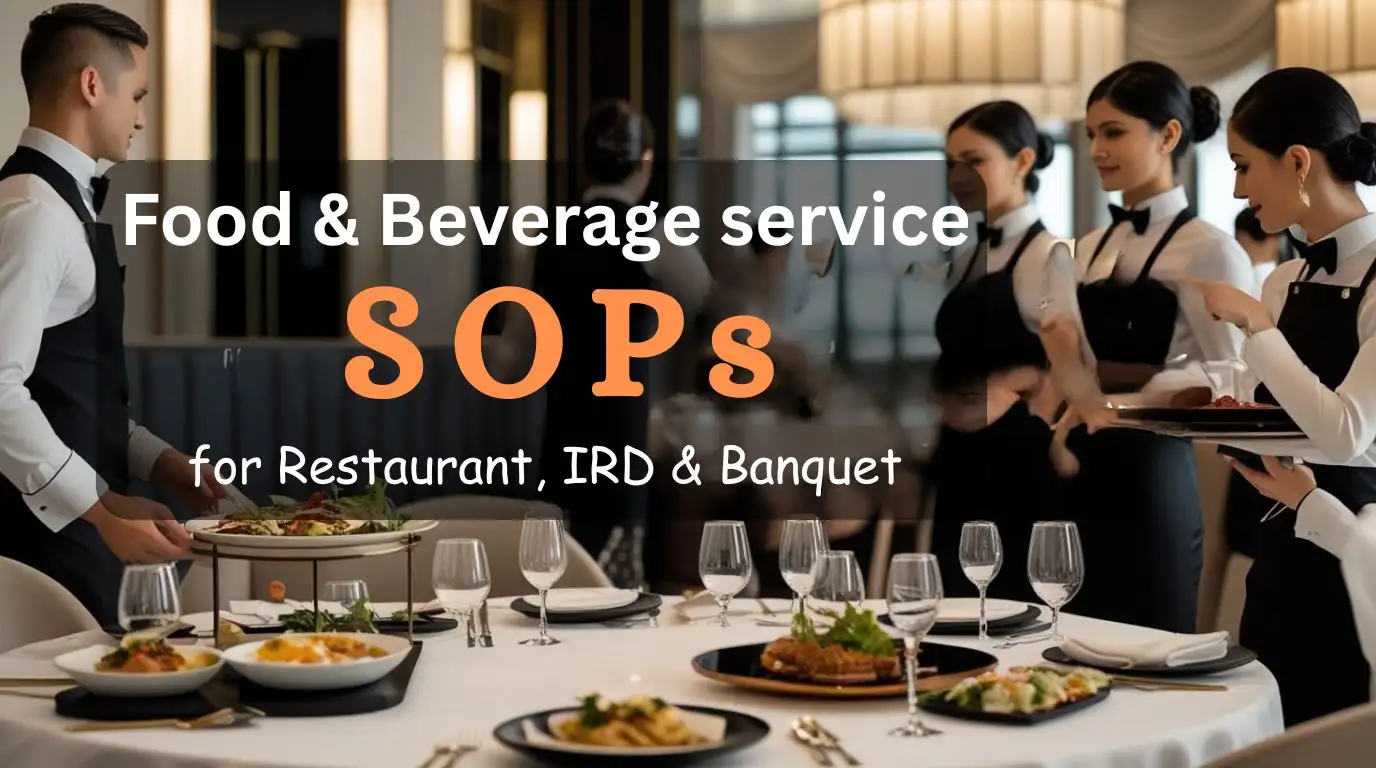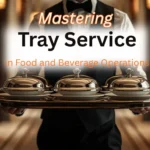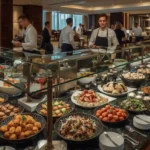What Are SOPs?
Standard Operating Procedures (SOPs) are formal, written guidelines that outline how to perform tasks consistently and efficiently. In the food and beverage (F&B) industry, SOPs help maintain service quality, hygiene, and guest satisfaction.
They serve as training tools for staff and reduce errors in daily operations. SOPs ensure compliance with health and safety regulations. They also streamline workflow and enhance team coordination. Overall, SOPs are essential for delivering a consistent and professional guest experience.
Importance of SOPs in F&B Service
- Consistency: Ensures uniform service standards across all staff members.
- Training Tool: Aids in onboarding new employees efficiently.
- Compliance: Helps meet health and safety regulations.
- Efficiency: Streamlines operations, reducing errors and waste.
- Customer Satisfaction: Enhances guest experience through reliable service.
In this guide, we will explore the essential Standard Operating Procedures (SOPs) across three key areas of Food & Beverage service, whether you’re a student, service staff, or a hospitality professional,.
This comprehensive resource covers best practices in Restaurant Service, In-Room Dining (IRD), and Banquet Operations. Let’s dive into the detailed procedures that ensure excellence and consistency in each of these service areas.
Restaurant Service SOPs
Learn the essential SOPs that guide every aspect of restaurant service—from welcoming guests to delivering meals and managing feedback. This section helps restaurant staff and students ensure smooth operations, excellent guest interaction, and consistent service quality.
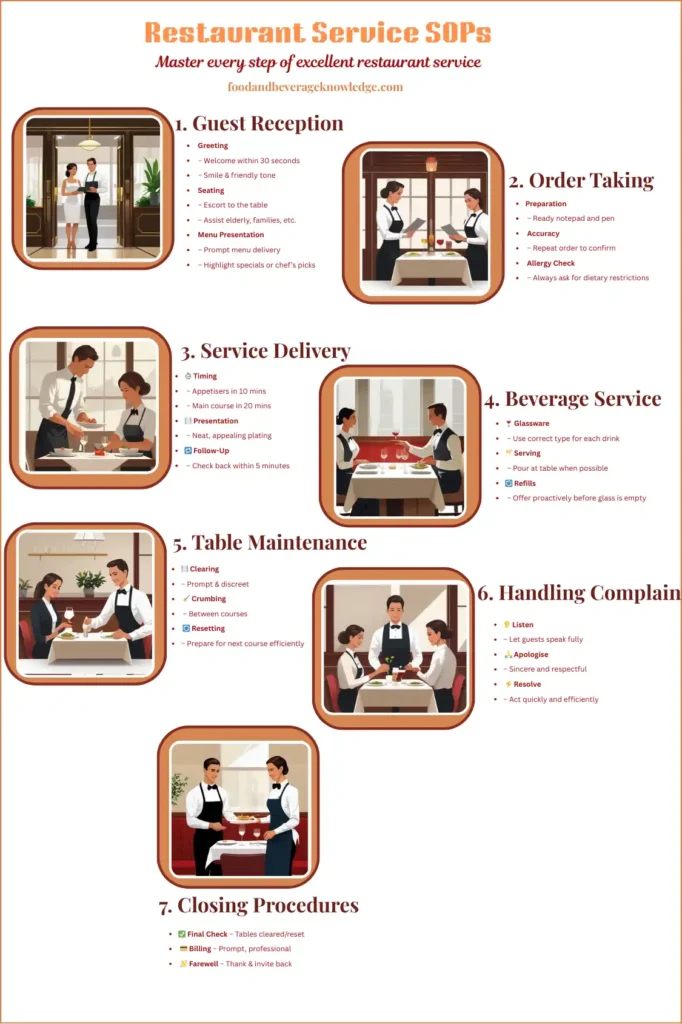
1. Guest Reception
Greeting: Welcome guests warmly within 30 seconds of arrival
- Greet guests with a friendly smile and a warm welcome as soon as they enter the restaurant.
- Aim to engage them within 30 seconds to set a positive tone for their experience.
- A prompt greeting ensures guests feel valued and ready to enjoy their dining experience.
Seating: Escort guests to their table, offering assistance as needed
- After greeting the guests, lead them to their assigned table with a polite and professional demeanour.
- Offer assistance with seating, especially for those who may need help (e.g., elderly guests or families with children).
- This personalised attention shows care and enhances guest comfort.
Menu Presentation: Provide menus promptly, highlighting specials
- Present the menu immediately after seating guests, ensuring they have all the options available to them.
- Point out any daily specials or chef’s recommendations to guide their decision-making.
- This provides a smooth transition into the ordering process while showcasing signature dishes.
2. Order Taking
Preparation: Ensure notepads and pens are ready
- Before taking orders, ensure you have a notepad and pen readily available to write down the details.
- Check that the tools are in good condition and easily accessible to avoid interruptions during the order-taking process.
- Being prepared helps maintain a smooth and efficient flow, ensuring no details are missed.
Accuracy: Repeat orders back to guests for confirmation
- After taking the order, repeat it back to the guest to confirm accuracy and avoid any misunderstandings.
- This step ensures that every item is correctly noted and provides the guest an opportunity to make changes if needed.
- Verifying orders helps reduce errors and improves guest satisfaction by confirming that their preferences are understood.
Allergy Checks: Inquire about dietary restrictions or allergies
- Always ask guests if they have any food allergies or dietary restrictions before taking their order.
- Document and relay this information to the kitchen to ensure safe food preparation and delivery.
- Proactively checking for allergies helps prevent health risks and shows guests that their well-being is a priority.
3. Service Delivery
Timing: Serve appetisers within 10 minutes, main courses within 20 minutes
- Ensure appetisers are served within 10 minutes and main courses within 20 minutes to maintain service efficiency.
- Adhering to these timing standards ensures a smooth dining experience and keeps guests satisfied.
Presentation: Ensure dishes are presented neatly and as per standards
- All dishes should be presented neatly, following restaurant presentation standards.
- Proper presentation enhances the guest experience and showcases the quality of the food.
Follow-Up: Check back with guests within 5 minutes of serving
- Follow up with guests within 5 minutes of serving to ensure satisfaction and address any concerns.
- Timely follow-up shows attentiveness and enhances guest satisfaction by resolving issues quickly.
4. Beverage Service
Glassware: Use appropriate glassware for each beverage
- Ensure the correct glassware is used for each type of beverage to enhance both presentation and taste.
- Using the right glassware reflects professionalism and improves the overall guest experience.
Serving: Pour beverages at the table when possible
- Whenever possible, serve beverages directly at the guest’s table for a more personalised experience.
- Pouring beverages at the table adds a touch of hospitality and attentiveness to the service.
Refills: Offer refills proactively
- Anticipate guest needs and offer refills before the glass is empty.
- Proactive refills show attentiveness and help maintain a seamless dining experience.
5. Table Maintenance
- Clearing: Remove used dishes promptly and discreetly.
- Crumbing: Crumb the table between courses to maintain cleanliness.
- Resetting: Prepare the table for the next course efficiently.
6. Handling Complaints
Listen: Allow guests to express concerns without interruption
- Listen carefully and attentively to any concerns guests may have, allowing them to speak without interruption.
- This approach shows respect and helps in understanding the issue fully before responding.
Apologise: Offer sincere apologies for any inconvenience
- Apologise sincerely for any inconvenience or issue the guest has experienced.
- A heartfelt apology demonstrates empathy and a commitment to guest satisfaction.
Resolve: Take immediate action to rectify the issue
- Take swift and decisive action to address and resolve the guest’s concern.
- Promptly resolving issues ensures guest satisfaction and reflects a high level of service professionalism.
7. Closing Procedures
- Final Check: Ensure all tables are cleared and reset.
- Billing: Present the bill promptly and process payments efficiently.
- Farewell: Thank guests and invite them to return.
If you want to learn for Laying Out a Guest Table SOP please visit tutorialspoint
In-Room Dining (IRD) SOPs
Explore step-by-step procedures for handling IRD—from taking guest calls professionally to delivering meals with precision and following up for feedback. Ideal for hotel staff aiming to master premium, personalised service in guest rooms.
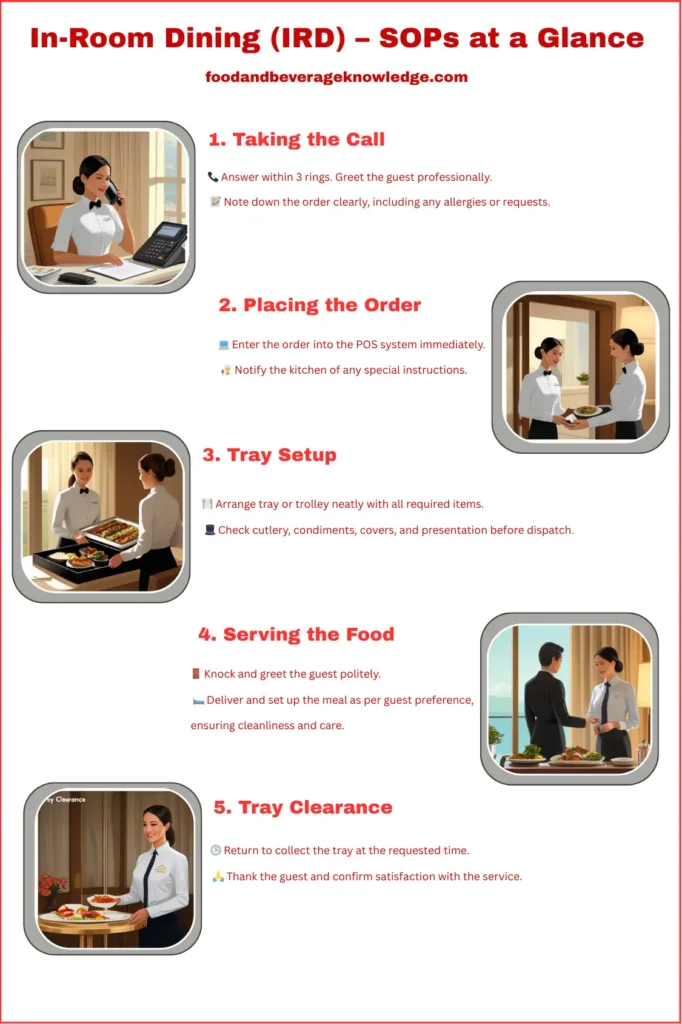
1. Preparation Before Answering Calls
- Workstation Readiness: Ensure the telephone, notepad, pen, and menu are readily available. Have the Point of Sale (POS) system open and functioning.
- Personal Presentation: Maintain a professional appearance. Sit or stand upright to project confidence and attentiveness.
2. Answering the Call
- Prompt Response: Answer the telephone within three rings to demonstrate efficiency.
- Standard Greeting: Use a friendly and professional tone: “Good [morning/afternoon/evening], In-Room Dining, this is [Your Name]. How may I assist you, Mr./Ms. [Guest’s Last Name]?”
3. Taking the Order
- Active Listening: Listen attentively without interrupting. Note down the order accurately, including any special requests or dietary restrictions.
- Menu Knowledge: Be familiar with the menu items, ingredients, preparation times, and availability. Inform the guest of any unavailable items or specials.
- Upselling Techniques: Suggest complementary items: “Would you like to add a beverage or dessert to your order?” Recommend popular or chef’s special dishes.
- Clarifying Details: Confirm the guest’s room number and name. Ask for specific preferences, such as cooking temperatures or condiment choices.
4. Confirming the Order
- Order Recap: Repeat the entire order back to the guest, including quantities and special instructions. “Mr./Ms. [Last Name], to confirm, you’ve ordered [list items]. Is that correct?”
- Delivery Time: Provide an estimated delivery time based on kitchen capacity. If delays are anticipated, inform the guest promptly and apologise for the inconvenience. “We anticipate a slight delay, and your order should arrive in approximately [time] minutes. We apologise for any inconvenience.”
5. Order Processing
- POS Entry: Enter the order accurately into the POS system immediately after the call. Double-check for any special instructions or modifications.
- Kitchen Communication: Relay any critical information to the kitchen staff, such as allergies or urgent requests.
6. Post-Call Procedures
- Documentation: Record the order details, including the time of order and the delivery estimate. Maintain logs for future reference and quality control.
- Guest Follow-Up: If necessary, call the guest to confirm delivery or address any issues.
7. Handling Special Situations
- Unavailable Items: Apologise and offer alternatives: “I’m sorry, the [item] is currently unavailable. May I suggest [alternative]?”
- Guest Complaints: Listen empathetically, apologise sincerely, and take immediate action to resolve the issue. “I apologise for the inconvenience. Let me address this immediately and ensure your satisfaction.”
- Language Barriers: Speak clearly and slowly. Use simple language and confirm understanding.
8. Quality Assurance
- Training: Regularly train staff on menu updates, customer service skills, and communication techniques.
- Feedback Collection: Encourage guests to provide feedback on their IRD experience. Use feedback to improve service quality continuously.
Learn: Roles and Responsibilities of a Food and Beverage Manager
SOPs for Banquet Service
Get detailed SOPs for banquet operations, including pre-event setup, coordinated service execution, guest handling, and post-event cleanup. Perfect for catering teams and banquet professionals delivering high-volume service with precision and hospitality

1. Pre-Event Preparation
- Briefing: Conduct a staff briefing to outline event details and assignments.
- Setup: Arrange tables, chairs, and decorations as per the event plan.
- Equipment Check: Ensure all service equipment is clean and functional.
2. Service Execution
- Guest Reception: Welcome guests and assist with seating.
- Meal Service: Serve meals promptly and in coordination with the kitchen.
- Beverage Service: Offer drinks and refills throughout the event.
3. Special Considerations
- Dietary Needs: Be aware of and accommodate special dietary requirements.
- VIP Guests: Provide enhanced service to VIP attendees.
- Event Flow: Coordinate with event organisers to adhere to the schedule.
4. Post-Event Procedures
- Cleanup: Clear tables and clean the event space promptly.
- Inventory: Account for all equipment and report any discrepancies.
- Feedback: Gather feedback from clients to improve future events.
Implementing and Maintaining SOPs
Developing SOPs
- Identify Tasks: List all routine operations in the F&B service.
- Detailed Steps: Break down each task into clear, actionable steps.
- Assign Responsibility: Specify who is responsible for each task.
- Review and Revise: Regularly update SOPs to reflect changes in operations.
Training Staff
- Orientation: Introduce new employees to SOPs during onboarding.
- Ongoing Training: Conduct regular refresher sessions.
- Assessments: Evaluate staff adherence to SOPs periodically.
Monitoring Compliance
- Checklists: Use daily checklists to ensure tasks are completed as per SOPs.
- Feedback: Encourage staff to provide input on SOP effectiveness.
- Audits: Conduct regular audits to identify areas for improvement.
Conclusion: Ensuring Excellence in F&B Service
In conclusion, SOPs are essential for maintaining high service standards in Restaurant Service, In-Room Dining (IRD), and Banquet Operations. They ensure consistent guest experiences, improve operational efficiency, and enhance guest satisfaction. By following these procedures, F&B professionals can deliver seamless service and create memorable dining experiences that keep guests coming back.
Related:
- Food and Beverage Service 101: The Basics, Types, and Roles Explained
- What Are the Types of Food and Beverage Service in the Hospitality Industry?
- Duties and Responsibilities of Food and Beverage Service Staff: A Comprehensive Guide
- Top 16 Attributes of Food and Beverage Service Staff
Subscribe and join our community of hospitality professionals & students — get insights, tips, and the latest updates delivered straight to your inbox!

